
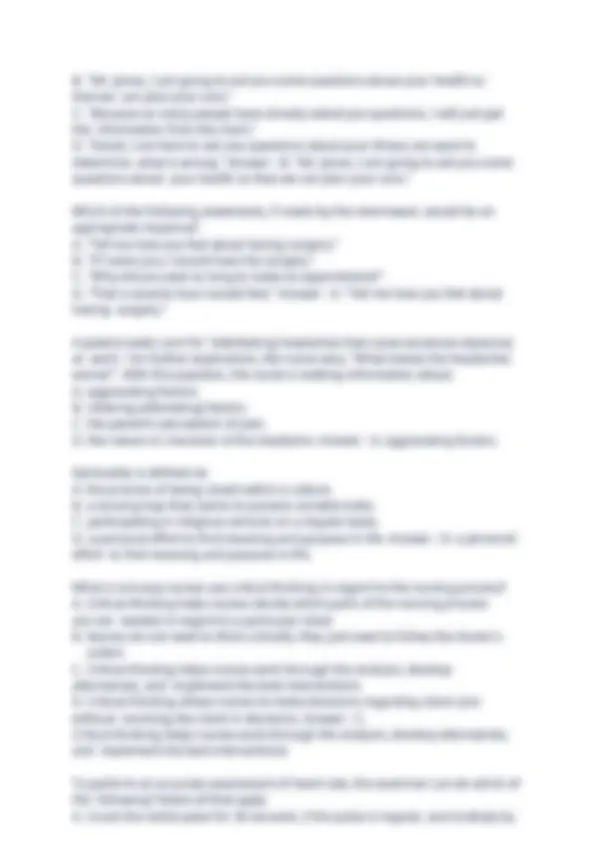
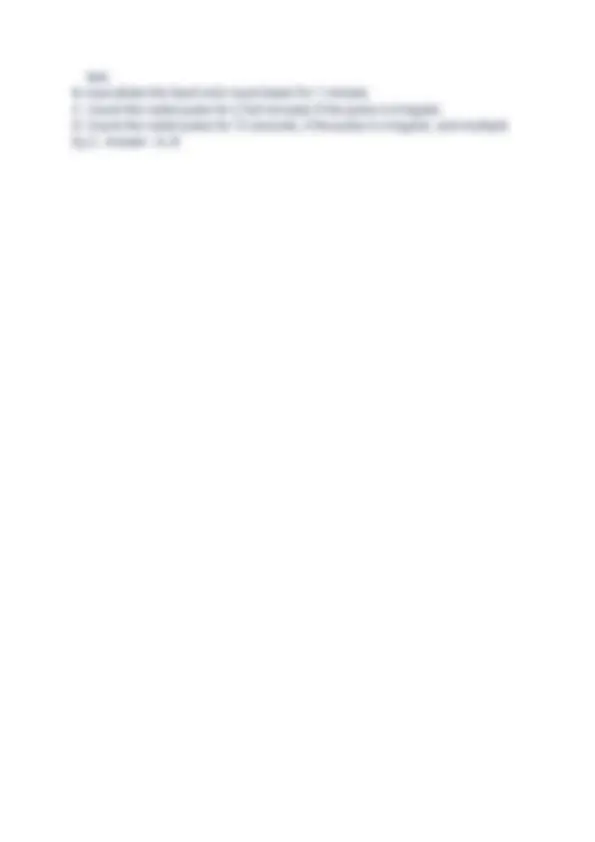
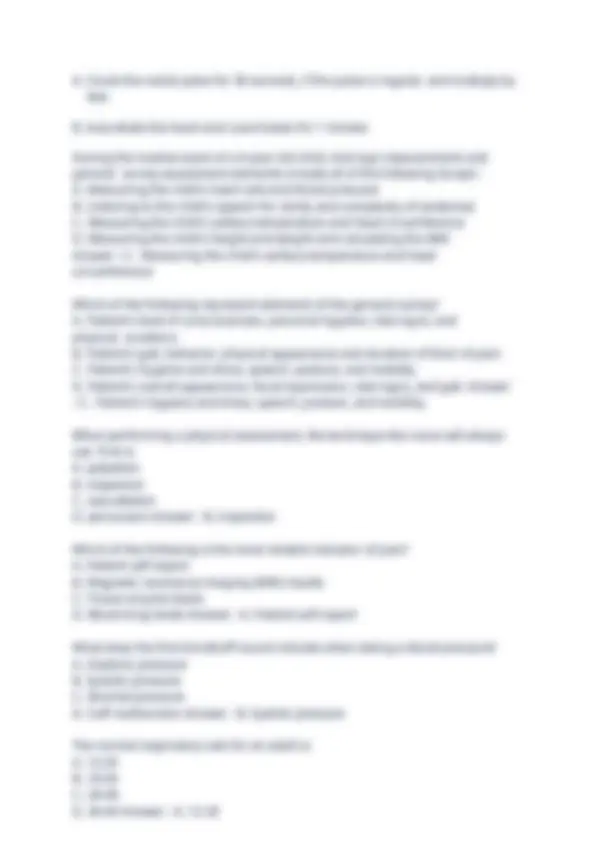
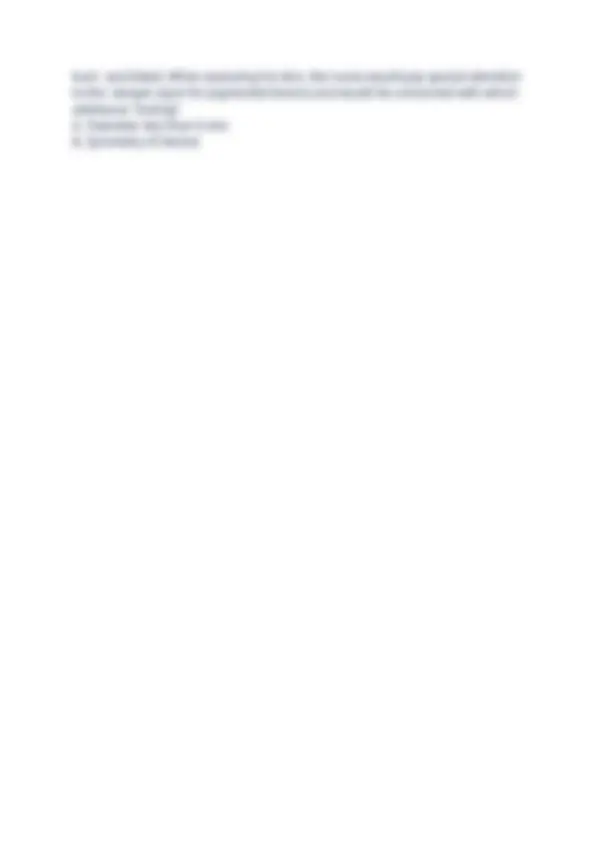
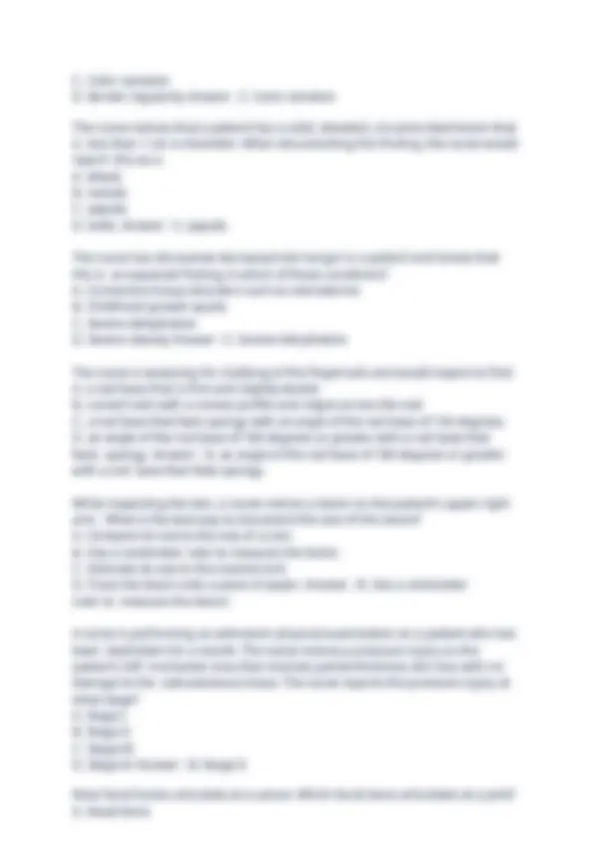

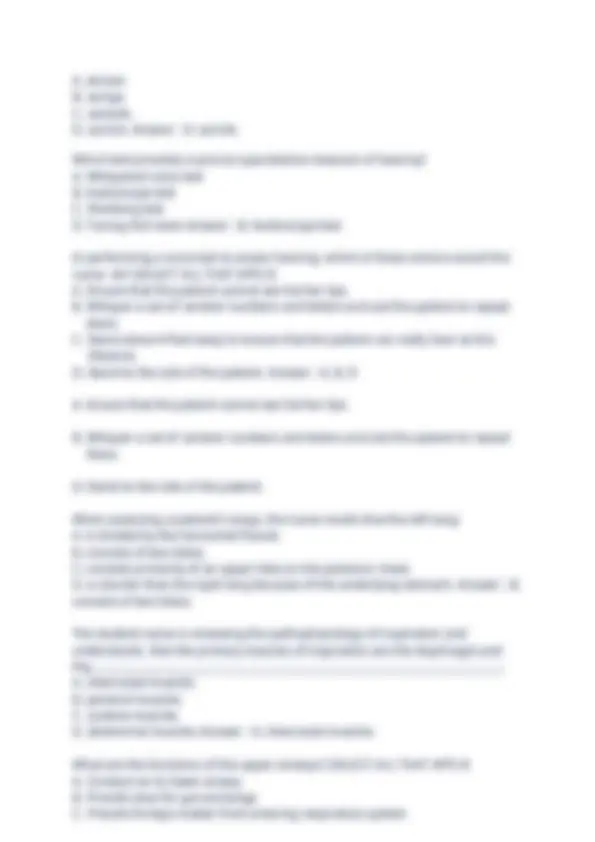
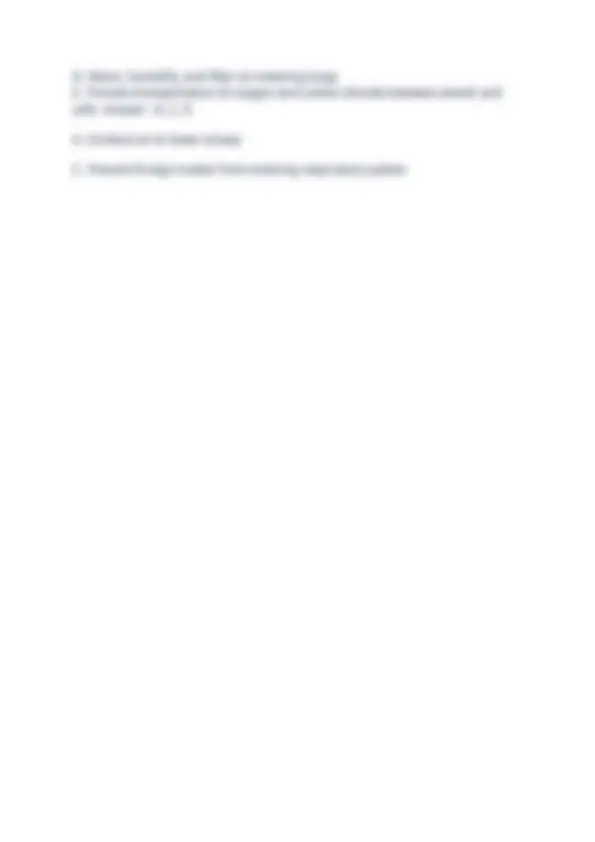
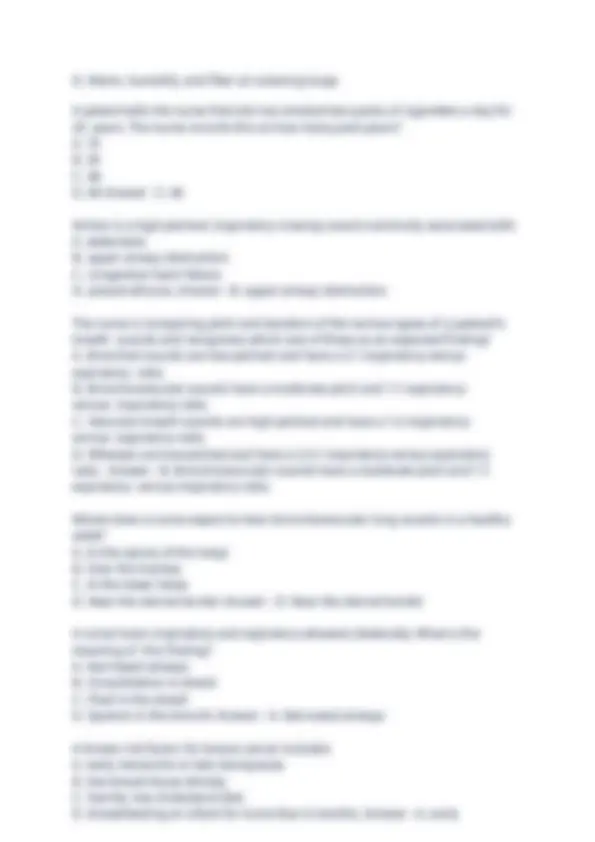
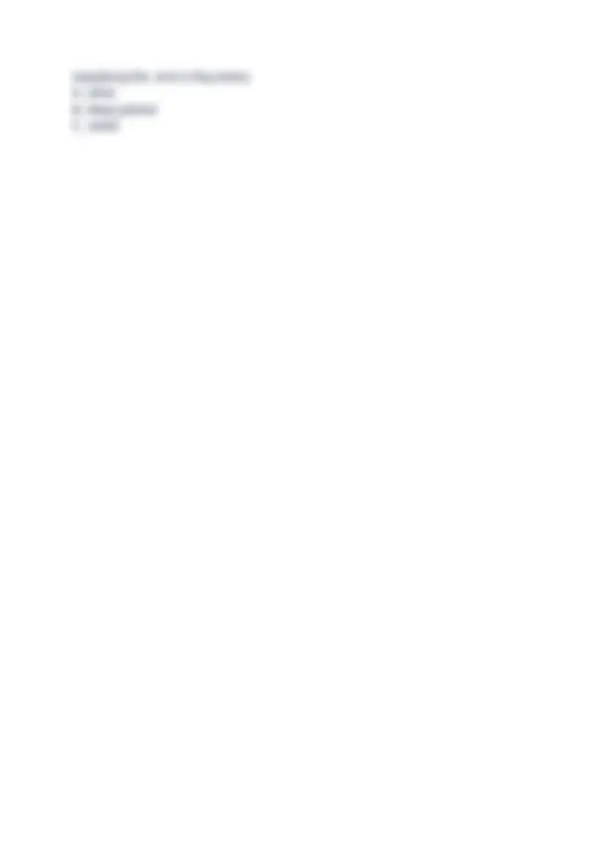
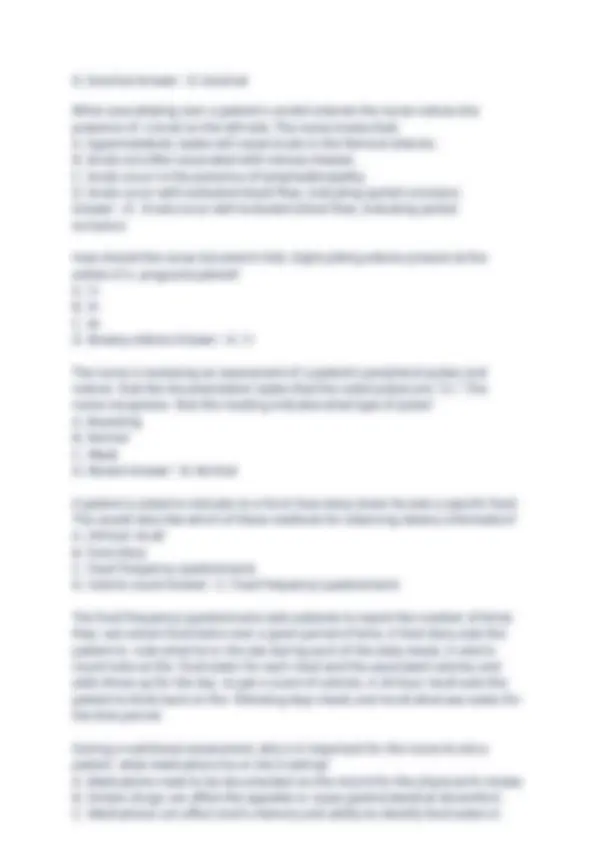
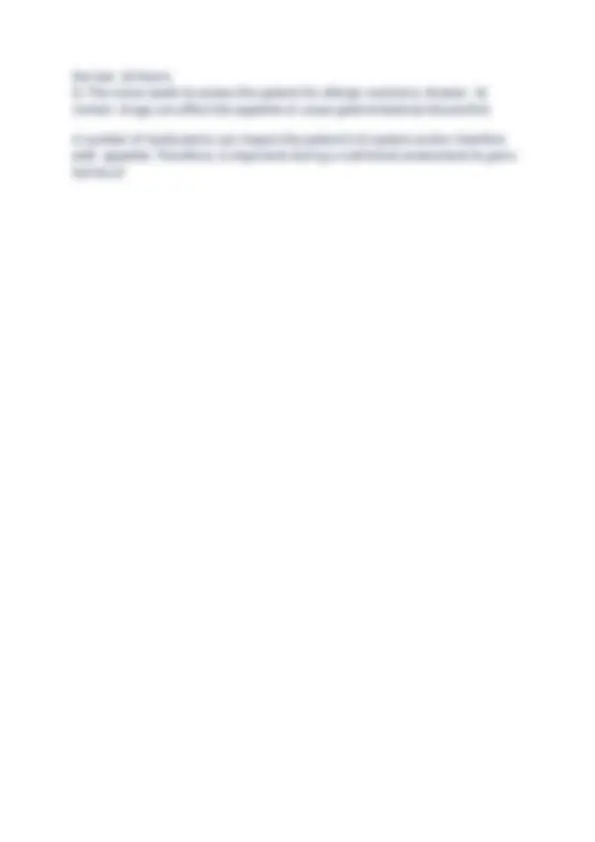
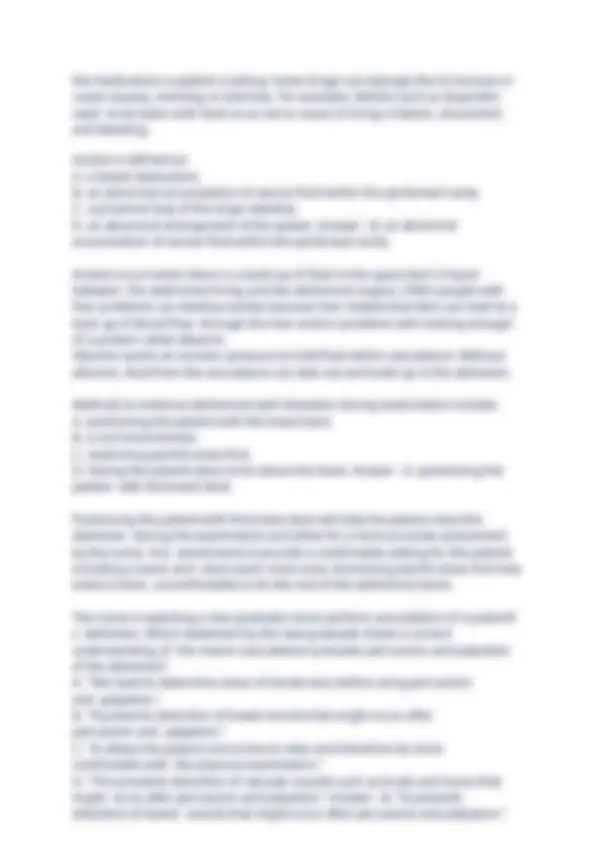

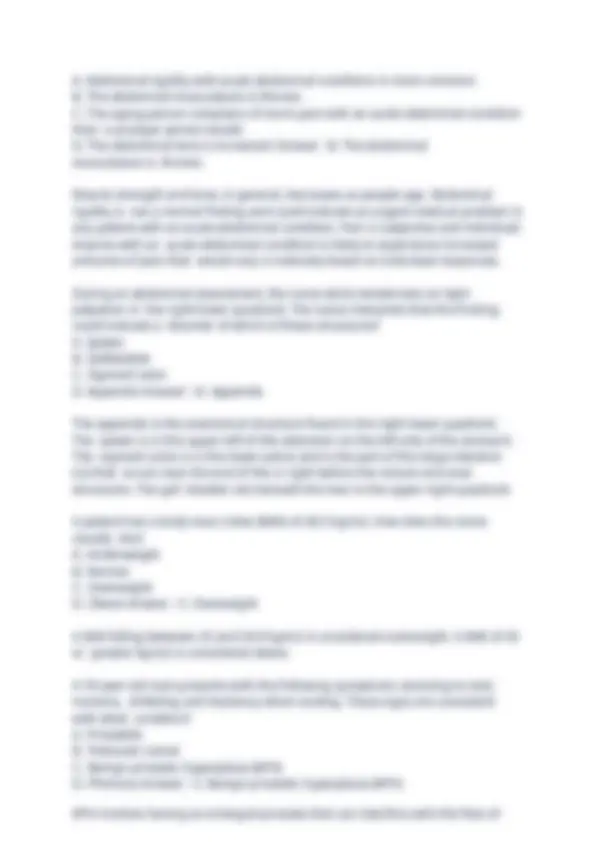
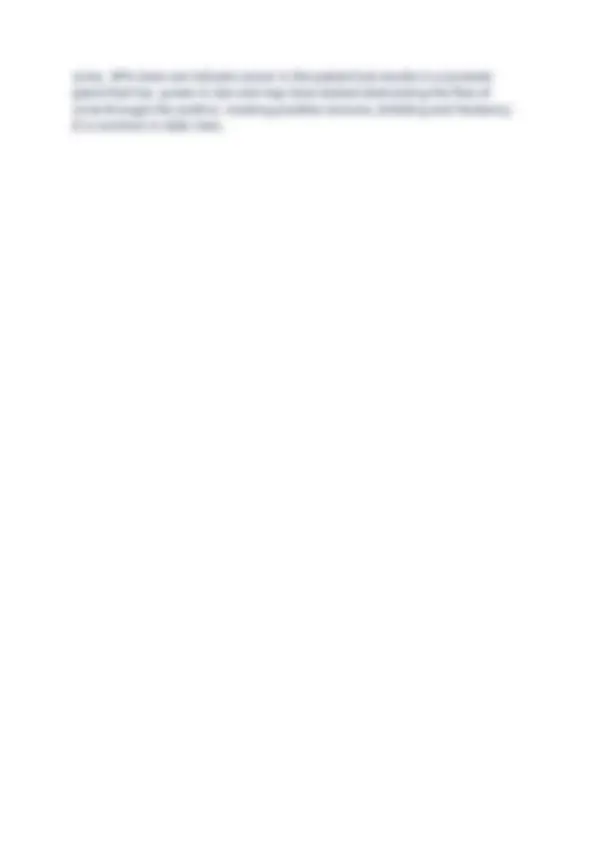
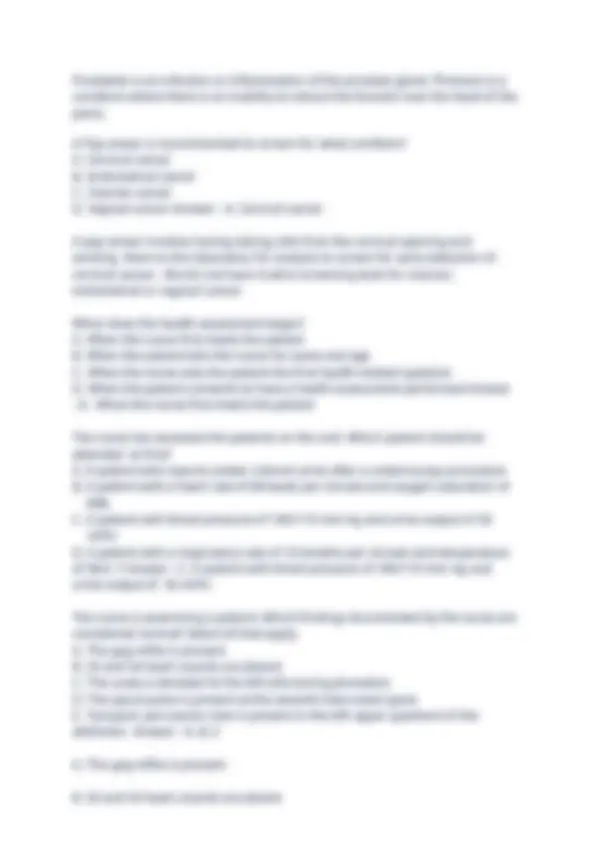
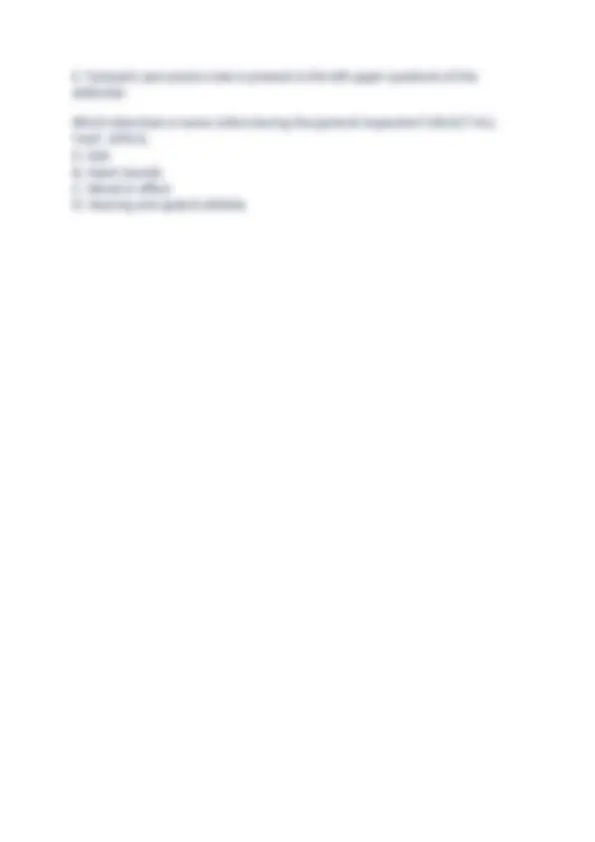
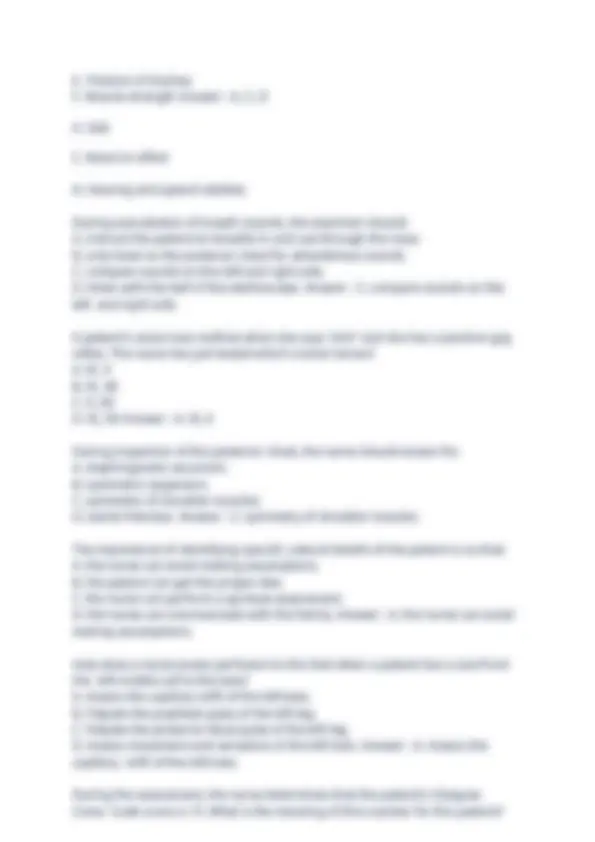
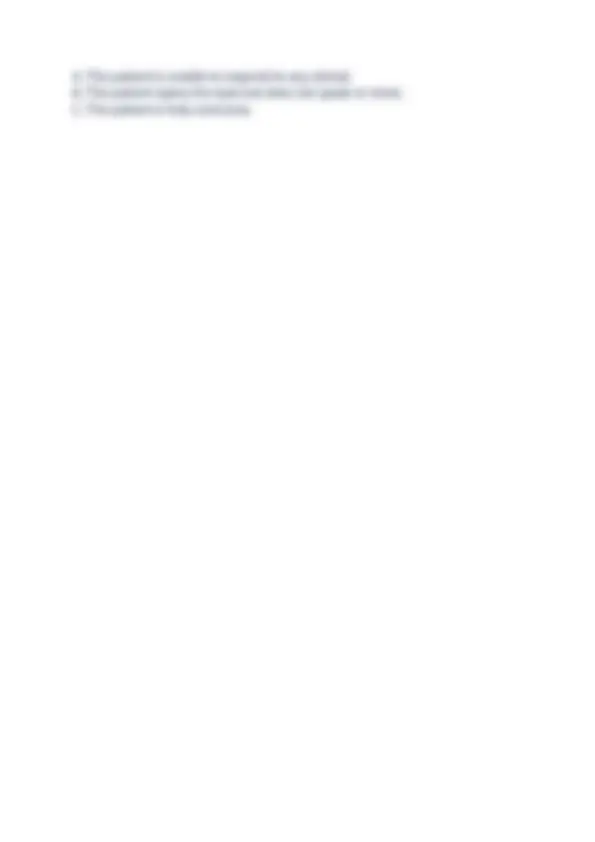
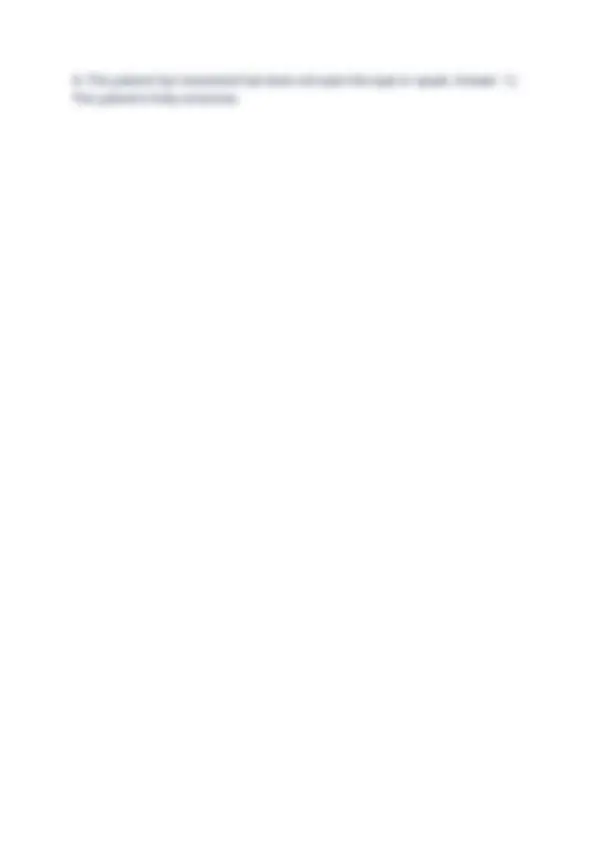


Study with the several resources on Docsity

Earn points by helping other students or get them with a premium plan


Prepare for your exams
Study with the several resources on Docsity

Earn points to download
Earn points by helping other students or get them with a premium plan
Community
Ask the community for help and clear up your study doubts
Discover the best universities in your country according to Docsity users
Free resources
Download our free guides on studying techniques, anxiety management strategies, and thesis advice from Docsity tutors
HAP Final Exam LOA Questions With 100% Correct Solutions.
Typology: Exams
1 / 29

This page cannot be seen from the preview
Don't miss anything!






















A student nurse is taking public transportation home after clinical. When she sees a friend, she immediately takes a seat next to her and begins a conversation, saying, "You know that older man who lives in the apartment next to you? Well, I took care of him today in the hospital." The student nurse is not respecting which of the following principles? A. fidelity B. benevolence C. confidentiality D. veracity Answer - C. confidentiality When recording information for the review of systems, the interviewer must document: A. objective data that supports the history of present illness. B. "negative" under the system heading. C. physical findings, such as skin appearance, to support historic data. D. the presence or absence of all symptoms under the system heading. Answer
adult patient is: A. "Mr. Jones, is it okay if I ask you some quick questions this morning about your health?"
two. B. Auscultate the heart and count beats for 1 minute. C. Count the radial pulse for 2 full minutes if the pulse is irregular. D. Count the radial pulse for 15 seconds, if the pulse is irregular, and multiple by 2. Answer - A, B
A. Count the radial pulse for 30 seconds, if the pulse is regular, and multiply by two. B. Auscultate the heart and count beats for 1 minute. During the routine exam of a 4 year old child, vital sign measurement and general survey assessment elements include all of the following Except : A. Measuring the child's heart rate and blood pressure B. Listening to the child's speech for clarity and complexity of sentences C. Measuring the child's axillary temperature and head circumference D. Measuring the child's height and weight and calculating the BMI Answer - C. Measuring the child's axillary temperature and head circumference Which of the following represent elements of the general survey? A. Patient's level of consciousness, personal hygiene, vital signs, and physical condition. B. Patient's gait, behavior, physical appearance and duration of their of pain. C. Patient's hygiene and dress, speech, posture, and mobility. D. Patient's overall appearance, facial expression, vital signs, and gait. Answer
D. Wear gloves to reduce the need for handwashing Answer - A. Wear gloves when in contact with patient's mucous membranes The dorsa of the hands are used to determine: A. temperature B. texture C. an organ's location D. vibration Answer - A. temperature A common error in blood pressure measurement includes: A. taking the blood pressure in an arm that is at the level of the heart. B. deflating the cuff about 2 mm Hg per heart beat. C. waiting less than 15 seconds before repeating the reading on the same arm. D. palpating the brachial artery before placing the blood pressure cuff. Answer - C. waiting less than 15 seconds before repeating the reading on the same arm. When taking the health history, the patient complains of pruritus. What is a common cause of this symptom? A. Allergic response B. Hyperpigmentation C. Excessive bruising D. Cancer Answer - A. Allergic response What term refers to a linear skin lesion that runs along a nerve route? A. Annular B. Shingles C. Dermatome D. Zosteriform Answer - D. Zosteriform The components of a nail examination include: A. shape, surface, and circulation. B. contour, consistency, and color. C. texture, toughness, and translucency. D. clubbing, pitting, and grooving. Answer - B. contour, consistency, and color. The nurse is bathing an 80-year-old man and notices that his skin is wrinkled, thin, lax, and dry. This finding would be related to which factor? A. Increased vascularity of the skin in the elderly B. Increased numbers of sweat and sebaceous glands in the elderly C. An increase in elasticity and an increase in subcutaneous fat in the elderly D. An increased loss of elasticity and a decrease in subcutaneous fat in the elderly Answer - D. An increased loss of elasticity and a decrease in subcutaneous fat in the elderly A patient tells the nurse that he has noticed that one of his moles has started to
burn and bleed. When assessing his skin, the nurse would pay special attention to the danger signs for pigmented lesions and would be concerned with which additional finding? A. Diameter less than 6 mm B. Symmetry of lesions
B. Mandible C. Maxilla D. Zygomatic bone Answer - B. Mandible
Which of the following statements is true in regard to the results obtained from use of the Snellen chart? A. The smaller the denominator, the poorer the vision. B. The larger the denominator, the poorer the vision. C. The larger the numerator, the better the vision. D. The smaller the numerator, the poorer the vision. Answer - B. The larger the denominator, the poorer the vision. During ocular examinations, the nurse keeps in mind that movement of the extraocular muscles is: A. stimulated by cranial nerves I and II. B. impaired in a patient with cataracts. C. stimulated by cranial nerves III, IV, and VI. D. decreased in the elderly. Answer - C. stimulated by cranial nerves III, IV, and VI. The nurse is testing a patient's visual accommodation, which refers to which action? A. Involuntary blinking in the presence of bright light B. Pupillary dilation when looking at a near object C. Pupillary constriction when looking at a near object D. Changes in peripheral vision in response to light Answer - C. Pupillary constriction when looking at a near object When assessing the pupillary light reflex, the nurse should use which technique? A. Shine a penlight from directly in front of the patient and inspect for pupillary constriction. B. Ask the patient to follow the penlight in eight directions and observe for bilateral pupil constriction. C. Shine a light across the pupil from the side and observe for direct and consensual pupillary constriction. D. Ask the patient to focus on a distant object. Then ask the patient to follow the penlight to about 7 cm from the nose. Answer - C. Shine a light across the pupil from the side and observe for direct and consensual pupillary constriction. During symptom analysis, the nurse helps the patient distinguish between dizziness and vertigo. Which description by the patient indicates vertigo? A. "I just could not keep my balance when I sat up." B. "It seemed that the room was spinning around." C. "I felt faint, like I was going to pass out." D. "I was afraid that I was going to lose consciousness." Answer - B. "It seemed that the room was spinning around." Which of the following behaviors demonstrated by an individual may be indicative of hearing loss?
A. atrium. B. auriga. C. aureole. D. auricle. Answer - D. auricle. Which test provides a precise quantitative measure of hearing? A. Whispered voice test B. Audioscope test C. Romberg test D. Tuning fork tests Answer - B. Audioscope test In performing a voice test to assess hearing, which of these actions would the nurse do? (SELECT ALL THAT APPLY) A. Ensure that the patient cannot see his/her lips. B. Whisper a set of random numbers and letters and ask the patient to repeat them. C. Stand about 4 feet away to ensure that the patient can really hear at this distance. D. Stand to the side of the patient. Answer - A, B, D A. Ensure that the patient cannot see his/her lips. B. Whisper a set of random numbers and letters and ask the patient to repeat them. D. Stand to the side of the patient. When assessing a patient?s lungs, the nurse recalls that the left lung: A. is divided by the horizontal fissure. B. consists of two lobes. C. consists primarily of an upper lobe on the posterior chest. D. is shorter than the right lung because of the underlying stomach. Answer - B. consists of two lobes. The student nurse is reviewing the pathophysiology of inspiration and understands that the primary muscles of inspiration are the diaphragm and the. A. intercostal muscles B. pectoral muscles C. scalene muscles D. abdominal muscles Answer - A. intercostal muscles What are the functions of the upper airways? (SELECT ALL THAT APPLY) A. Conduct air to lower airway B. Provide area for gas exchange C. Prevent foreign matter from entering respiratory system
D. Warm, humidify, and filter air entering lungs E. Provide transportation of oxygen and carbon dioxide between alveoli and cells Answer - A, C, D A. Conduct air to lower airway C. Prevent foreign matter from entering respiratory system
menarche or late menopause. The nurse is reviewing statistics regarding breast cancer. Which group of women over the age of 45 in the United States has the highest incidence for development of breast cancer?
A. American Indian B. White C. Asian D. African-American Answer - B. White The first heart sound (S1) is produced by the: A. closure of the semilunar valves. B. closure of the atrioventricular (AV) valves. C. opening of the semilunar valves. D. opening of the atrioventricular (AV) valves. Answer - B. closure of the atrioventricular (AV) valves. The semilunar valves separate the: A. atria from the veins. B. atria from the ventricles. C. right atria from the left atria. D. ventricles from the arteries. Answer - D. ventricles from the arteries. The component of the conduction system referred to as the pacemaker of the heart is the: A. sinoatrial (SA) node. B. bundle branches. C. atrioventricular (AV) node. D. bundle of His. Answer - A. sinoatrial (SA) node. During an assessment of a healthy adult, where would the nurse expect to palpate the apical pulse? A. Third left intercostal space at the midclavicular line B. Fourth left intercostal space at the sternal border C. Fourth left intercostal space at the anterior axillary line D. Fifth left intercostal space at the midclavicular line Answer - D. Fifth left intercostal space at the midclavicular line During a cardiovascular assessment, the nurse knows that a "thrill" is: A. a murmur auscultated at the third intercostal space. B. associated with ventricular atrophy. C. palpated in the right epigastric area. D. a vibration that is palpable. Answer - D. a vibration that is palpable. Claudication is caused by: A. varicose veins. B. venous insufficiency. C. stasis ulcerations. D. arterial insufficiency. Answer - D. arterial insufficiency. The nurse is reviewing the blood supply to the arm. The major artery
D. brachial Answer - D. brachial When auscultating over a patient's carotid arteries the nurse notices the presence of a bruit on the left side. The nurse knows that: A. hypermetabolic states will cause bruits in the femoral arteries. B. bruits are often associated with venous disease. C. bruits occur in the presence of lymphadenopathy. D. bruits occur with turbulent blood flow, indicating partial occlusion. Answer - D. bruits occur with turbulent blood flow, indicating partial occlusion. How should the nurse document mild, slight pitting edema present at the ankles of a pregnant patient? A. 1+ B. 3+ C. 4+ D. Brawny edema Answer - A. 1+ The nurse is reviewing an assessment of a patient's peripheral pulses and notices that the documentation states that the radial pulses are "2+." The nurse recognizes that this reading indicates what type of pulse? A. Bounding B. Normal C. Weak D. Absent Answer - B. Normal A patient is asked to indicate on a form how many times he eats a specific food. This would describe which of these methods for obtaining dietary information? A. 24-hour recall B. Food diary C. Food frequency questionnaire D. Calorie count Answer - C. Food frequency questionnaire The food frequency questionnaire asks patients to report the number of times they eat certain food items over a given period of time. A food diary asks the patient to note what he or she ate during each of the daily meals. A calorie count looks at the food eaten for each meal and the associated calories and adds those up for the day to get a count of calories. A 24-hour recall asks the patient to think back on the following days meals and recall what was eaten for the time period. During a nutritional assessment, why is it important for the nurse to ask a patient what medications he or she is taking? A. Medications need to be documented on the record for the physician?s review. B. Certain drugs can affect the appetite or cause gastrointestinal discomfort. C. Medications can affect one?s memory and ability to identify food eaten in
the last 24 hours. D. The nurse needs to assess the patient for allergic reactions. Answer - B. Certain drugs can affect the appetite or cause gastrointestinal discomfort. A number of medications can impact the patient's GI system and/or interfere with appetite. Therefore, is important during a nutritional assessment to get a full list of